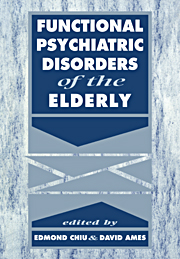Book contents
- Frontmatter
- Contents
- List of contributors
- Preface
- Introduction – A personal note
- Acknowledgement
- Part 1 Classification
- Part 2 General epidemiology
- Part 3 Neuroses
- 4 Panic disorders in the elderly
- 5 Obsessive–compulsive disorder in the elderly
- 6 Generalized anxiety and phobic disorders
- Part 4 Affective disorders
- Part 5 Psychosexual disorders
- Part 6 Substance use and abuse
- Part 7 Schizophrenia and related psychoses
- Part 8 Psychological, biological and medical issues
- Part 9 Treatment methods
- Part 10 Conclusion
- Index
5 - Obsessive–compulsive disorder in the elderly
from Part 3 - Neuroses
Published online by Cambridge University Press: 13 November 2009
- Frontmatter
- Contents
- List of contributors
- Preface
- Introduction – A personal note
- Acknowledgement
- Part 1 Classification
- Part 2 General epidemiology
- Part 3 Neuroses
- 4 Panic disorders in the elderly
- 5 Obsessive–compulsive disorder in the elderly
- 6 Generalized anxiety and phobic disorders
- Part 4 Affective disorders
- Part 5 Psychosexual disorders
- Part 6 Substance use and abuse
- Part 7 Schizophrenia and related psychoses
- Part 8 Psychological, biological and medical issues
- Part 9 Treatment methods
- Part 10 Conclusion
- Index
Summary
Introduction
Obsessive–compulsive disorder (OCD) has been a hidden disease. It was thought to be uncommon, largely untreatable when it occurred, and was thought to be treated mostly in specialty units. It was believed possible to be helped when depression was associated with OCD in that treatment of depression was often associated with remission of the OCD. In recent years, epidemiological studies have suggested a general population prevalence of about 2 % for OCD. Previous data had relied on numbers of patients attending specialist facilities, while ignoring morbidity in the general community. Furthermore, new and more effective psychological and physical treatments have resulted in renewed interest in diagnosing and treating this disabling disorder.
Almost nothing has been written about OCD in the elderly. This is despite the fact that it would be expected that approximately 2 % of the elderly would be affected by OCD and that it is both disabling and potentially treatable. The failure to diagnose OCD in the elderly may reflect the general way in which this is a hidden disorder. Many patients are embarrassed and reluctant to talk about the problem, or reveal it, even to people close to them. Elderly sufferers may lead relatively restricted lives without their OCD being challenged and made manifest by the need to cope with a job and raise a family. As the disabilities would have waxed and waned over the course of their lives, there may also have been an assumption on the patient's part, as well as that of their attending doctors, that any symptoms are simply ‘the way that person is’, or assumed to be a personality trait, rather than reflecting a disorder which is eminently treatable.
- Type
- Chapter
- Information
- Functional Psychiatric Disorders of the Elderly , pp. 62 - 77Publisher: Cambridge University PressPrint publication year: 1994

